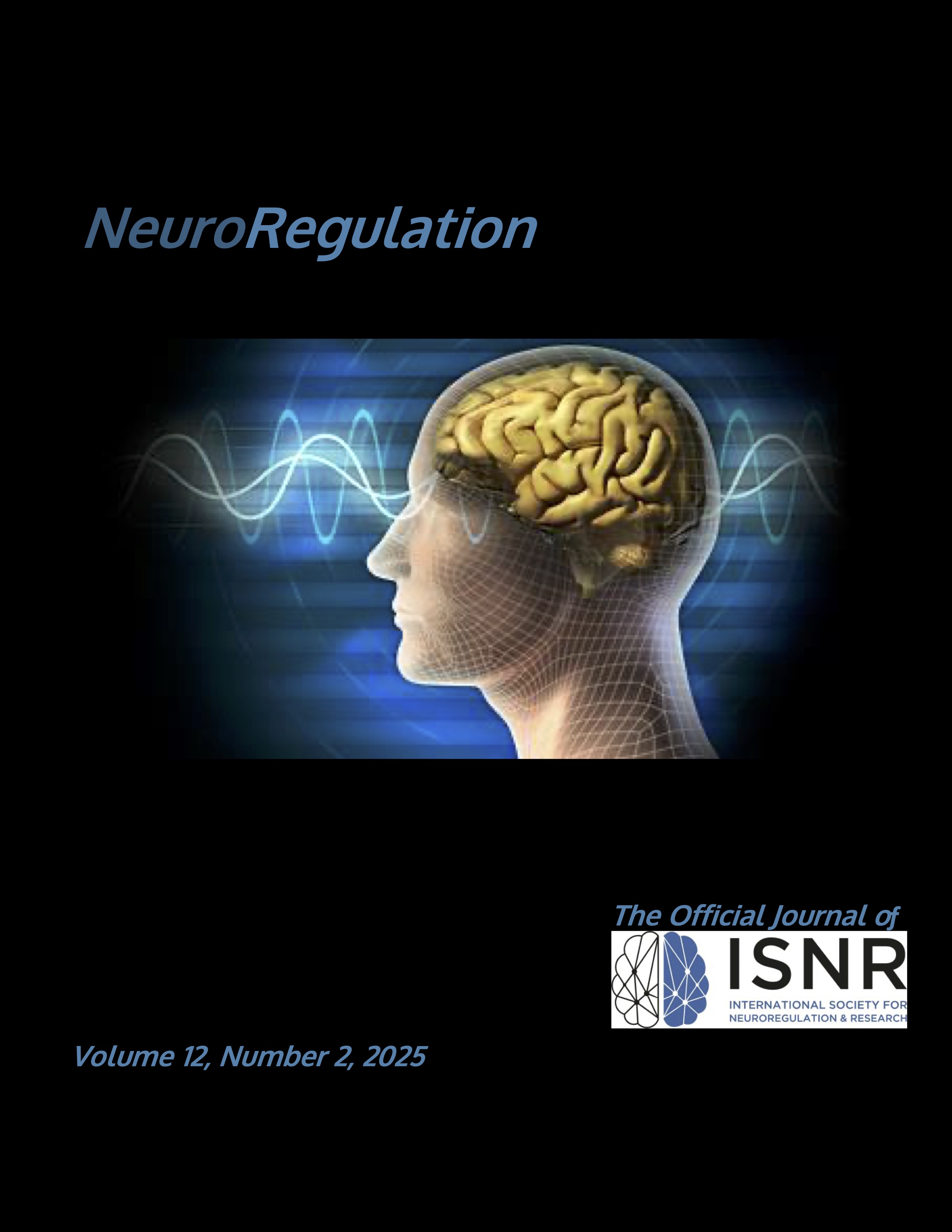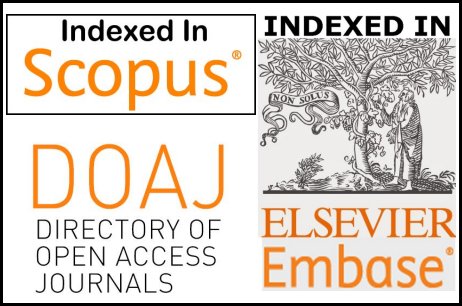The Applications of the Mindfulness-Based Cognitive Therapy and HRV Biofeedback in Modern Psychotherapy
DOI:
https://doi.org/10.15540/nr.12.2.98Keywords:
heart rate variability (HRV), autonomic, biofeedback, mindfulnessAbstract
This study evaluated the effectiveness of heart rate variability biofeedback (HRVB) and mindfulness-based cognitive therapy (MBCT) in diagnosing and treating stress and anxiety. HRVB provides real-time data on the autonomic nervous system (ANS), highlighting the balance between its sympathetic and parasympathetic functions, while MBCT, combined with breathing exercises, targets the parasympathetic system, promoting positive thought reconstruction. A 22-year-old male with extreme anxiety and palpitations underwent a 12-week psychotherapeutic program involving HRVB and MBCT techniques. He practiced daily personalized breathing and mindfulness exercises, integrating them into daily activities. The results showed a shift from a stressed sympathetic ANS state to a relaxed parasympathetic one. He also demonstrated the ability to control his heart rate and improve thought patterns, leading to better emotional balance. This study highlights the combined potential of HRVB and MBCT in enhancing stress resilience, vitality, and autonomic balance, highlighting HRVB's pivotal role in tracking patient progress in clinical settings.
References
Azam, M. A., Katz, J., Mohabir, V., & Ritvo, P. (2016). Individuals with tension and migraine headaches exhibit increased heart rate variability during post-stress mindfulness meditation practice but a decrease during a post-stress control condition—A randomized, controlled experiment. International Journal of Psychophysiology, 110, 66–74. https://doi.org/10.1016/j.ijpsycho.2016.10.011
Baer, R. A. (2003). Mindfulness training as a clinical intervention: A conceptual and empirical review. Clinical Psychology: Science and Practice, 10(2), 125–143. https://doi.org/10.1093/clipsy.bpg015
Biocom Technologies. (2023). Health assessment products with heart rate variability analysis (HRV). Biocom Technologies. https://www.biocomtech.com/
Bouchard, S., Bernier, F., Boivin, E., Morin, B., & Robillard, G. (2012). Using biofeedback while immersed in a stressful videogame increases the effectiveness of stress management skills in soldiers. PLoS ONE, 7(4), Article e36169. https://doi.org/10.1371/journal.pone.0036169
Carlstedt, R. (Ed.). (2018). Handbook of sport neuroscience and psychophysiology. Routledge.
Dalenberg, C. (2014). The treatment of trauma: Integrating HRV and cognitive behavior therapy. Paper presented at the Association of Applied Psychophysiology and Biofeedback Meeting, Savannah, GA.
Delizonna, L. L., Williams, R. P., & Langer, E. J. (2009). The effect of mindfulness on heart rate control. Journal of Adult Development, 16(2), 61–65. https://doi.org/10.1007/s10804-009-9050-6
Ditto, B., Eclache, M., & Goldman, N. (2006). Short-term autonomic and cardiovascular effects of mindfulness body scan meditation. Annals of Behavioral Medicine, 32(3), 227–234. https://doi.org/10.1207/s15324796abm3203_9
Edwards, L. (2011) Biofeedback, meditation, and mindfulness. Biofeedback, 39(2), 67–70. https://doi.org/10.5298/1081-5937-39.2.02
Evans, S., Ferrando, S., Findler, M., Stowell, C., Smart, C., & Haglin, D. (2008). Mindfulness-based cognitive therapy for generalized anxiety disorder. Journal of Anxiety Disorders, 22, 716–721. https://doi.org/10.1016/j.janxdis.2007.07.005
Fournié, C., Chouchou, F., Dalleau, G., Caderby, T., Cabrera, Q., & Verkindt, C. (2021). Heart rate variability biofeedback in chronic disease management: A systematic review. Complementary Therapies in Medicine, 60. https://doi.org/10.1016/j.ctim.2021.102750
Gevirtz, R. (2000). Resonant frequency training to restore homeostasis for treatment of psychophysiological disorders. Biofeedback, 27, 7–9.
Gevirtz, R. N. (2007). Psychophysiological perspectives on stress-related and anxiety disorders. In P. M. Lehrer, R. L. Woolfolk, & W. E. Sime (Eds.), Principles and practice of stress management (3rd ed., pp. 209–226). The Guilford Press.
Gevirtz, R. (2011). Autonomic nervous system markers for psychophysiological, anxiety, and physical disorders. In E. K. Gordon & S. H., Koslow (Ed.), Integrative neuroscience and personalized medicine (pp. 164–180). Oxford Press.
Gevirtz, R. (2013). The promise of heart rate variability biofeedback: Evidence-based application. Biofeedback, 41, 110–120. https://doi.org/10.5298/1081-5937-41.3.01
Gevirtz, R. (2015). Integrating heart rate variability biofeedback into mindfulness-based therapies. Biofeedback, 43(3), 129–132. https://doi.org/10.5298/1081-5937-43.3.03
Gevirtz, R. (2020). Incorporating heart rate variability biofeedback into acceptance and commitment therapy. Biofeedback, 48(1), 16–19. https://www.doi.org/10.5298/1081-5937-48.01.05
Gevirtz, R., & Lehrer, P. (2003). Resonant frequency heart rate biofeedback. In M. S. Schwartz & F. Andrasik (Eds.), Biofeedback: A practitioner's guide (3rd ed.). Guilford Press.
Giardino, A., Lehrer, P., & Feldman, J. M. (2000). The role of oscillations in self-regulation: A revision of the classical model of homeostasis. In D. Kenney, J. G. Carlson, F. J. McGuigan, & J. L. Sheppard (Eds.), Stress and health: Research and clinical applications (pp. 27–52). Harwood.
Goldberg, R. C. (2022). Exploring the relationships among bio-psycho-social measures of stress: A multifactorial approach towards the evaluation and reduction of stress (Order No. 28869139). ProQuest Central (2617235663). https://www.proquest.com/dissertations-theses/exploring-relationships-among-bio-psycho-social/docview/2617235663/se-2
Henriques, G., Keffer, S., Abrahamson, C., Jeanne Horst, S. (2011). Exploring the effectiveness of a computer-based heart rate variability biofeedback program in reducing anxiety in college students. Applied Psychophysiology and Biofeedback 36, 101–112. https://doi.org/10.1007/s10484-011-9151-4
Kabat-Zinn, J. (1990). Full catastrophe living: Using the wisdom of your body and mind to face stress, pain, and illness. Delacorte.
Kemp, A. H., Quintana, D. S., Felmingham, K. L., Matthews, S., & Jelinek, H. F. (2012). Depression, comorbid anxiety disorders, and heart rate variability in physically healthy, unmedicated patients: Implications for cardiovascular risk. PLoS ONE, 7(2), Article e30777. https://doi.org/10.1371/journal.pone.0030777
Kenny, M. A., & Williams, J. M. G. (2006). Treatment-resistant depressed patients show a good response to mindfulness-based cognitive therapy. Behaviour Research and Therapy, 45(3), 617–625. https://doi.org/10.1016/j.brat.2006.04.008
Khazan, I. Z. (2013). The clinical handbook of biofeedback: A step-by-step guide for training and practice with mindfulness. Wiley-Blackwell.
Kim, A. S., Mi, H. J., & Min, J. S. (2021). Effects of mindfulness-based stress reduction (MBSR) on stress, heart rate variability, affect, and wellbeing among people with schizophrenia. International Journal of Environmental Research and Public Health, 18(22), Article 11871. https://doi.org/10.3390/ijerph182211871
Krygier, J. R., Heathers, J. A., Shahrestani, S., Abbott, M., Gross, J. J., & Kemp, A. H. (2013). Mindfulness meditation, well-being, and heart rate variability: A preliminary investigation into the impact of intensive Vipassana meditation. International Journal of Psychophysiology, 89(3), 305–313. https://doi.org/10.1016/j.ijpsycho.2013.06.017
La Rovere, M. T., Bigger, J. T., Marcus, F. I., Mortara, A., & Schwartz, P. J. (1998). Baroreflex sensitivity and heart-rate variability in prediction of total cardiac mortality after myocardial infarction. The Lancet, 351(9101), 478–484. https://doi.org/10.1016/S0140-6736(97)11144-8
Lehrer, P. (2007). Biofeedback training to increase heart rate variability. In P. M. Lehrer & R. L. Woolfolk (Eds.), Principles and practice of stress management (3rd ed.). Guilford Press.
Lehrer, P. M., & Gevirtz, R. (2014). Heart rate variability biofeedback: How and why does it work? Psychology for Clinical Setting, 5, Article 756. https://doi.org/10.3389/fpsyg.2014.00756
Lehrer, P. M., Vaschillo, E., & Vaschillo, B. (2000). Resonant frequency biofeedback training to increase cardiac variability: Rationale and manual for training. Applied Psychophysiology and Biofeedback, 25(3), 177–191. https://doi.org/10.1023/A:1009554825745
Malik, M., Bigger, J. T., Camm, A. J., Kleiger, R. E., Malliani, A., Moss, A. J., & Schwartz, P. J. (1996). Heart rate variability: Standards of measurement, physiological interpretation, and clinical use. European Heart Journal, 17(3), 354–381. https://doi.org/10.1093/oxfordjournals.eurheartj.a014868
Moore, M., Brow, D., Money, N., & Bates, M. (2011). Mind–body skills for regulating the autonomic nervous system. Defense Centers of Excellence for Psychological Health & Traumatic Brain Injuries.
O’Leary, K., O’Neill, S., & Dockray, S. (2015). A systematic review of the effects of mindfulness interventions on cortisol. Journal of Health Psychology, 21(9), 2108–2121. https://doi.org/10.1177/1359105315569095
Peressutti, C., Martin-González, J. M., & García-Manso, J. M. (2012). Does mindfulness meditation shift the cardiac automatic nervous system to a highly orderly operational state? International Journal of Cardiology, 154(2), 120–122. https://doi.org/10.1016/j.ijcard.2011.10.054
Peressutti, C., Martín-González, J. M., García-Manso, J. M., & Mesa, D. (2010). Heart rate dynamics in different levels of Zen meditation. International Journal of Cardiology, 145(1), 142–146. https://doi.org/10.1016/j.ijcard.2009.06.058
Prinsloo, G. E., Derman, W. E., Lambert, M. I., & Rauch, H. G. L. (2013). The effect of a single session of short duration biofeedback-induced deep breathing on measures of heart rate variability during laboratory-induced cognitive stress: A pilot study. Applied Psychophysiology and Biofeedback, 38(2), 81–90. https://doi.org/10.1007/s10484-013-9210-0
Sanada, K., Montero-Marin, J., Díez, M. A., Salas-Valero, M., Pérez-Yus, M. C., Morillo, H., Demarzo, M. M. P., García-Toro, M., & García-Campayo, J. (2016). Effects of mindfulness-based interventions on salivary cortisol in healthy adults: A meta-analytical review. Frontiers in Physiology, 7, Article 471. https://doi.org/10.3389/fphys.2016.00471
Segerstrom, S. C., & Nes, L. S. (2007). Heart rate Variability reflects self-regulatory strength, effort, and fatigue. Psychological Science, 18(3), 275–281. https://doi.org/10.1111/j.1467-9280.2007.01888.x
Steffen, P. R., Foxx, J., Cattani, K., Alldredge, C., Austin, T., & Burlingame, G. M. (2021). Impact of a 12-week group-based compassion focused therapy intervention on heart rate variability. Applied Psychophysiology Biofeedback, 46, 61–68. https://doi.org/10.1007/s10484-020-09487-8
Tabachnick, L. (2015). Biofeedback and anxiety disorders: A critical review of EMG, EEG, and HRV feedback. Concept, 38, 1–26.
Teasdale, J. D., Segal, Z. V., Williams, J. M. G., Ridgeway, V. A., Soulsby, J. M., & Lau, M. A. (2000). Prevention of relapse/recurrence in major depression by mindfulness-based cognitive therapy. Journal of Consulting and Clinical Psychology, 68(4), 615–623. https://doi.org/10.1037/0022-006x.68.4.615
van Aalderen, J. R., Donders, A. R., Giommi, F., Spinhoven, P., Barendregt, H. P., & Speckens, A. E. (2012). The efficacy of mindfulness-based cognitive therapy in recurrent depressed patients with and without a current depressive episode: A randomized controlled trial. Psychological Medicine, 42(5), 989–1001. https://doi.org/10.1017/S0033291711002054
van der Zwan, de Vente, W., Huizink, A. C., Bögels, S. M., & de Bruin, E. I. (2015). Physical activity, mindfulness meditation, or heart rate variability biofeedback for stress reduction: A randomized controlled trial. Applied Psychophysiology and Biofeedback, 40(4), 257–268. https://doi.org/10.1007/s10484-015-9293-x
Wells, R., Outhred, T., Heathers, J. A., Quintana, D. S., & Kemp, A. H. (2012). Matter over mind: A randomised-controlled trial of single-session biofeedback training on performance anxiety and heart rate variability in musicians. PLoS ONE, 7(10), Article e46597. https://doi.org/10.1371/journal.pone.0046597
Zucker, T. L., Samuelson, K. W., Muench, F., Greenberg, M. A., & Gevirtz, R. N. (2009). The effects of respiratory sinus arrhythmia biofeedback on heart rate variability and posttraumatic stress disorder symptoms: A pilot study. Applied Psychophysiology and Biofeedback, 34, 135–143. https://doi.org/10.1007/s10484-009-9085-2
Downloads
Published
Issue
Section
License
Copyright (c) 2025 Martin Kramar

This work is licensed under a Creative Commons Attribution 4.0 International License.
Authors who publish with this journal agree to the following terms:- Authors retain copyright and grant the journal right of first publication with the work simultaneously licensed under a Creative Commons Attribution License (CC-BY) that allows others to share the work with an acknowledgement of the work's authorship and initial publication in this journal.
- Authors are able to enter into separate, additional contractual arrangements for the non-exclusive distribution of the journal's published version of the work (e.g., post it to an institutional repository or publish it in a book), with an acknowledgement of its initial publication in this journal.
- Authors are permitted and encouraged to post their work online (e.g., in institutional repositories or on their website) prior to and during the submission process, as it can lead to productive exchanges, as well as earlier and greater citation of published work (See The Effect of Open Access).











